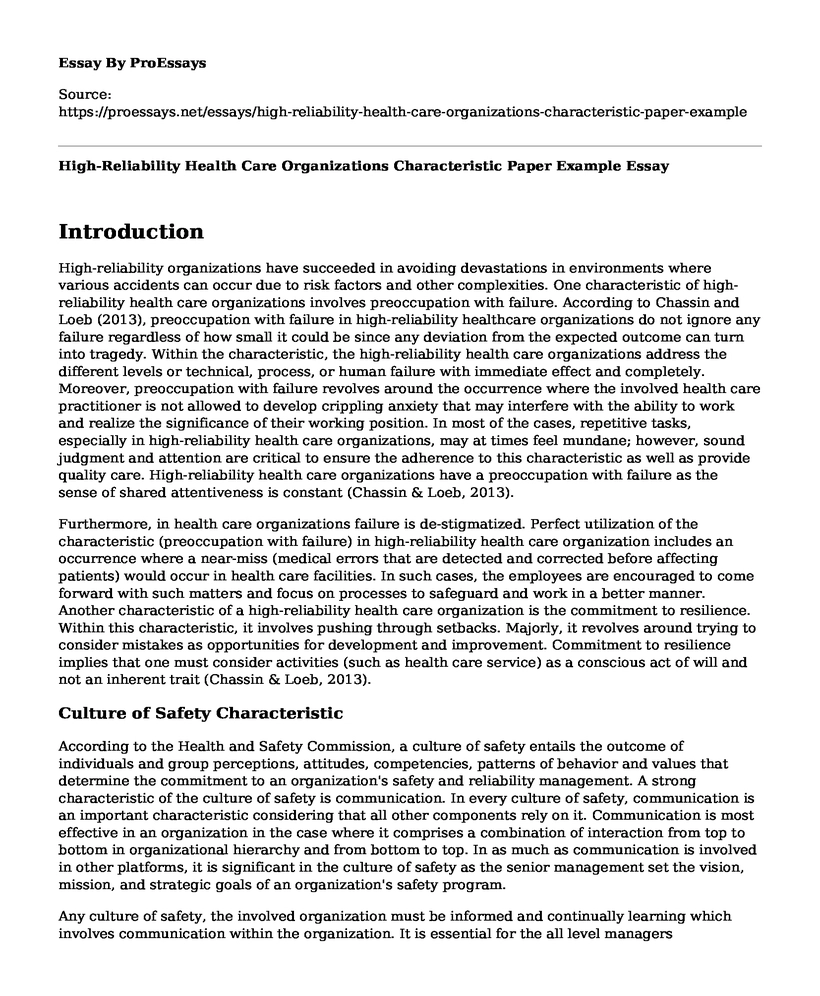Introduction
High-reliability organizations have succeeded in avoiding devastations in environments where various accidents can occur due to risk factors and other complexities. One characteristic of high-reliability health care organizations involves preoccupation with failure. According to Chassin and Loeb (2013), preoccupation with failure in high-reliability healthcare organizations do not ignore any failure regardless of how small it could be since any deviation from the expected outcome can turn into tragedy. Within the characteristic, the high-reliability health care organizations address the different levels or technical, process, or human failure with immediate effect and completely. Moreover, preoccupation with failure revolves around the occurrence where the involved health care practitioner is not allowed to develop crippling anxiety that may interfere with the ability to work and realize the significance of their working position. In most of the cases, repetitive tasks, especially in high-reliability health care organizations, may at times feel mundane; however, sound judgment and attention are critical to ensure the adherence to this characteristic as well as provide quality care. High-reliability health care organizations have a preoccupation with failure as the sense of shared attentiveness is constant (Chassin & Loeb, 2013).
Furthermore, in health care organizations failure is de-stigmatized. Perfect utilization of the characteristic (preoccupation with failure) in high-reliability health care organization includes an occurrence where a near-miss (medical errors that are detected and corrected before affecting patients) would occur in health care facilities. In such cases, the employees are encouraged to come forward with such matters and focus on processes to safeguard and work in a better manner. Another characteristic of a high-reliability health care organization is the commitment to resilience. Within this characteristic, it involves pushing through setbacks. Majorly, it revolves around trying to consider mistakes as opportunities for development and improvement. Commitment to resilience implies that one must consider activities (such as health care service) as a conscious act of will and not an inherent trait (Chassin & Loeb, 2013).
Culture of Safety Characteristic
According to the Health and Safety Commission, a culture of safety entails the outcome of individuals and group perceptions, attitudes, competencies, patterns of behavior and values that determine the commitment to an organization's safety and reliability management. A strong characteristic of the culture of safety is communication. In every culture of safety, communication is an important characteristic considering that all other components rely on it. Communication is most effective in an organization in the case where it comprises a combination of interaction from top to bottom in organizational hierarchy and from bottom to top. In as much as communication is involved in other platforms, it is significant in the culture of safety as the senior management set the vision, mission, and strategic goals of an organization's safety program.
Any culture of safety, the involved organization must be informed and continually learning which involves communication within the organization. It is essential for the all level managers (supervisory, middle, and senior) to communicate the strategy to ensure that all the employees observe their assigned tasks and deliver as expected. Equally, it is critical that the employee provide feedback concerning their assigned tasks along with every relevant information (Pidgeon et al., 2018). In as much as the subordinates deliver feedback, the management is accustomed to listen and that the input with relevant concern along with acting on the necessary interventions. For effective communication, all the essential aspects of communication need consideration which ranges from the different forms of communication. Similarly, since a culture of safety revolves around the outcomes from individual and group interaction, it forms a significant characteristic. According to Pidgeon et al. (2018), a culture of safety requires various operations such as reflection upon any safety-related practices in minimizing exposure to hazards.
References
Chassin, M. R., & Loeb, J. M. (2013). Highreliability health care: getting there from here. The Milbank Quarterly, 91(3), 459-490.
Pidgeon, N. F., Turner, B. A., Blockley, D. I., & Toft, B. (2018). Corporate safety culture: improving the management contribution to system reliability. In Reliability 91 (pp. 682-690). Chapman and Hall/CRC.
Cite this page
High-Reliability Health Care Organizations Characteristic Paper Example. (2022, Nov 07). Retrieved from https://proessays.net/essays/high-reliability-health-care-organizations-characteristic-paper-example
If you are the original author of this essay and no longer wish to have it published on the ProEssays website, please click below to request its removal:
- Paper Sample on Asthma
- Pathophysiology Assessment Case Study
- The Issue of Vaccination Annotated Bibliography
- World Federation of the Deaf Review Paper Example
- Paper Example on Lower Health Care Costs: A Necessity for Family Wellbeing
- Essay Sample on Muscular Dystrophy: Impact, Types & Statistics
- Spanish Flu & COVID-19: Respiratory Diseases & Their Comparisons - Essay Sample







